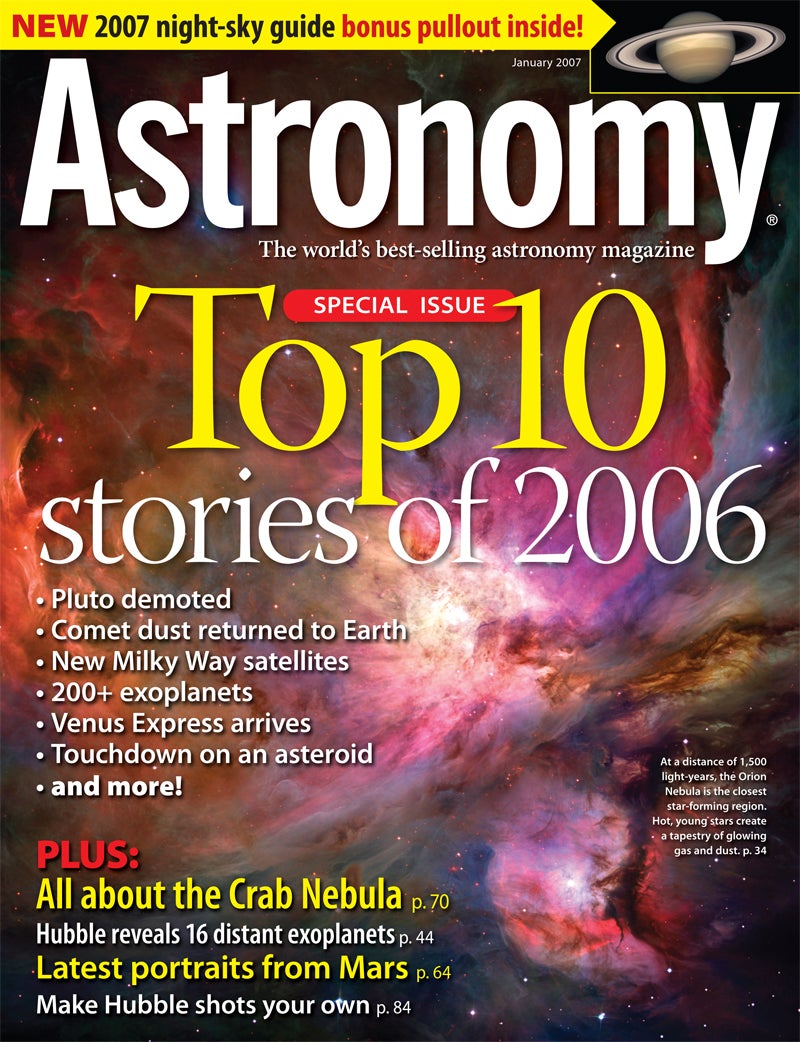
Astronomy news
This week’s sky events
Astronomy basics
Glossary of astronomical terms
Return to Astronomy “For the media” page
Decembet 5, 2006
WAUKESHA, WI – 2006 will go down as an important year in space-exploration history. Pluto lost its planetary status, the European Space Agency sent a spacecraft to Venus, and scientists got humanity’s first look at cometary dust particles – and the solar system’s formation.
In its January 2007 issue (available on newsstands now), Astronomy magazine counts down the top 10 space stories of 2006 and previews six stories to watch in 2007.
To discuss the top space stories of 2006 with an Astronomy editor, please contact Matt Quandt at 262.798.6484 or mquandt@kalmbach.com.
The year’s top stories
Associate Editor Francis Reddy covers the hottest stories of the last year in “Top 10 astronomy stories of 2006.”
Number 10: A successful Discovery mission put NASA back on track after the February 2003 Columbia tragedy.
Number 9: the Mars Reconnaissance Orbiter (MRO) grazed Mars’ atmosphere 426 times.
Number 8: Venus Express ended a 12-year hiatus in Venus exploration.
In an upset, the year’s most talked about story – Pluto’s demotion from planet to dwarf planet – came in at number 3.
The number 1 spot belongs to NASA’s Stardust mission, whose findings imply there was large-scale mixing going on in the early solar system – and possibly beyond.
The January 2007 Astronomy not only reflects on a year of excitement but includes stories on Hubble’s discovery of 16 exotic exoplanets, our fascination with life on Mars, and our ever-growing understanding of stellar evolution.
Hubble does it again
Ray Villard, a frequent contributor to Astronomy and News Director for the Space Telescope Science Institute, reports in “Hubble discovers 16 exotic planets” that the space observatory imaged 16 new “hot Jupiters” through SWEEPS – the Sagittarius Window Eclipsing Extrasolar Planet Search. This accomplishment opened a new parcel of exoplanet-discovery space. The SWEEPS observation provides compelling evidence that 6 billion Jupiter-like planets may exist in the Milky Way. This gives astronomers a new arena for pondering the variety of worlds across the galaxy.
“Portraits from Mars”
NASA’s Spirit and Opportunity rovers have thrived on Mars for nearly 3 years, returning thousands of spectacular images to Earth. Although not the first to image the Red Planet, Spirit and Opportunity are the first to send back high-resolution, true-color panoramic images, giving scientists the first-ever “human views” of Mars. Jim Bell, leader of the Spirit and Opportunity Pancam color imaging team at Cornell University, merges art and science to bring us “Portraits from Mars,” a planetary photo album of some of the most beautiful and desolate vistas to date.
Also in the January 2007 Astronomy
Astronomy promotes the science and hobby of astronomy through high-quality publications that engage, inform, entertain, and inspire.









